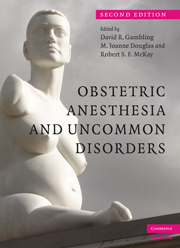Book contents
- Frontmatter
- Contents
- List of plates
- List of contributors
- Preface
- Section 1 Cardiovascular and respiratory disorders
- 1 Structural heart disease in pregnant women
- 2 Disorders of cardiac conduction
- 3 Vascular diseases
- 4 Respiratory disorders in pregnancy
- Section 2 Musculoskeletal disorders
- Section 3 Nervous system disorders
- Section 4 Metabolic disorders
- Section 5 Other disorders
- Index
- Plate Section
- References
2 - Disorders of cardiac conduction
from Section 1 - Cardiovascular and respiratory disorders
Published online by Cambridge University Press: 19 October 2009
- Frontmatter
- Contents
- List of plates
- List of contributors
- Preface
- Section 1 Cardiovascular and respiratory disorders
- 1 Structural heart disease in pregnant women
- 2 Disorders of cardiac conduction
- 3 Vascular diseases
- 4 Respiratory disorders in pregnancy
- Section 2 Musculoskeletal disorders
- Section 3 Nervous system disorders
- Section 4 Metabolic disorders
- Section 5 Other disorders
- Index
- Plate Section
- References
Summary
Introduction
Disorders of cardiac conduction seen in pregnancy are those involving abnormal impulse generation or propagation (supraventricular, ventricular dysrhythmias, heart blocks) and specific conduction disorders (preexcitation syndromes, long QT syndrome). The clinical implications and current management of some familiar disorders of conduction during pregnancy are discussed but there is an emphasis on the more uncommon disorders of cardiac conduction.
Physiologic heart rate and rhythm changes in pregnancy (see Table 2.1)
In conjunction with the antepartum rise in blood volume, resting heart rate (HR) increases steadily by 10–15% throughout pregnancy, reaching a peak of 10 to 20 beats above baseline during the third trimester. During labor and delivery, sinus tachycardia is seen, with maximal HR occurring peripartum. Parturients with more labor pain may have higher sympathetic tone and higher peripartum HR.
Electrocardiogram (EKG) changes during pregnancy include shift of QRS axis in any direction, the appearance of small q waves in Lead III, T wave inversion and, commonly, ST-T changes. ST segment depression, coinciding with maximal HR and usually asymptomatic, has been reported during nonoperative and operative deliveries. ST changes may result from tachycardia, hormonal milieu, heart position changes, venous air emboli, hypokalemia, and hyperventilation. It is unclear whether the sympathectomy produced by regional anesthesia affects the ECG but both ST segment depression (> 1 mm) and ST elevation have been reported during cesarean section (C/S). The clinical significance of ST changes remains uncertain.
- Type
- Chapter
- Information
- Obstetric Anesthesia and Uncommon Disorders , pp. 29 - 56Publisher: Cambridge University PressPrint publication year: 2008
References
- 1
- Cited by



